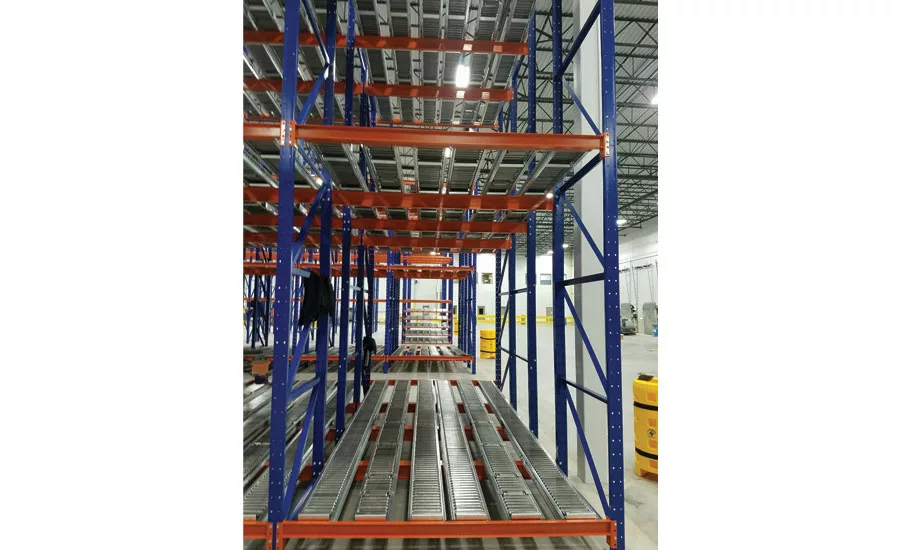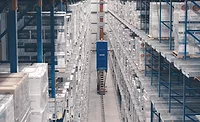Storage systems, ASRS address space issues in beverage plants
Automated storage and retrieval systems can provide 50 percent more space

In the 2018 movie “Mary Poppins Returns,” the catchy new tune “Nowhere to Go But Up” proclaims that “as you fly over town, it gets harder to frown. And we’ll all hit the heights if we never look down.” To keep up with burgeoning stock, warehouse experts are “looking up” and strategizing storage solutions that deal with decreased high-moving SKUs and the challenges of “long tail” slow-moving products.
In addition to the proliferation of SKUs, the volumes being delivered to customers have drastically changed, says Darrell Dunham, president of Cirrus Tech Inc., Kearney, Neb. “In most cases, you can’t just order 15 of a slow-moving SKU at a time. You typically have to order a full pallet,” Dunham explains. “If you only need 15 of the product for the month, but you get a pallet of 75, that pallet is now needing to be stored, in most cases very inefficiently from how much space it takes to store. You can’t stack anything on top of it, you need to store it for five months and take it down and to replenish the pick location five to 10 times over the life of that pallet.
“This is where an [automated storage retrieval system] (ASRS) comes in really handy, especially if you can replenish your highest volume SKUs,” he continues. “Consolidating these SKUs frees up 50 percent or more space in your existing warehouse, giving you the room to more efficiently ‘deal’ with the long tail. It’s a triple win with the density of storage freeing up significant space, only touching your highest volume SKUs (60-80 percent of your volume) once and you can now more efficiently handle your slower moving items.”
Paul Laman, vice president of food and beverage at DMW&H, Fairfield, N.J., also notes the “long tail of SKUs,” which often result in much lower storage density. “Warehouses are regularly getting taller and are being equipped with higher density storage systems, such as ASRS, pushback racking and tall narrow aisle racking.
“A decade ago, the high-volume SKUs were basically stored in bulk by stacking two to four pallets on the floor, [while] slower moving SKUs were stored in standard storage racking,” he continues. “Today, many warehouses can get twice as many cases stored per square foot using the latest in storage strategy optimization.”
Optimal organization
To keep up with product diversity, lightweight packaging and more, storage systems are broadening their appeal to include shelving and carton flow. Racking also is becoming more sophisticated, according to Ron Hassenfratz, president and owner of Distribution Technologies, Plano, Texas.
“To address these added items within the same cubic feet of storage space, distributors are adding fixtures such as shelving and carton flow to store and locate these added SKUs,” he says.
Hassenfratz details how the racking system is used to organize products in a given space. “The majority of space is taken up by the product and by the operating aisles to access the loads,” Hassenfratz says.
While pallet sizes have remained unchanged in the past 50 years, pallets are an important common denominator between production, distribution and transportation, he adds.
Warehouse management systems (WMS) and the Internet of Things (IoT) continues to play a pivotal role in the functionality of beverage warehouse storage systems, experts say.
“Software is key to any storage, picking and order fulfillment operation,” says Tom Steininger, market development director at Grand Rapids, Mich.-based Dematic Corp.
When it comes to storage technologies, Steininger cites the following as integral to today’s storage needs: high-speed deep lane pallet storage systems, which provide more density and ability to support shipping, layer picking and case picking operations; storage of individual cases to support high-speed automated case picking; and storage of open top cases to support bottle picking either manually or robotically.
David Schwebel, vice president of business development and market intelligence at Swisslog Logistics, Newport News, Va., highlights important technology and software advancements that are taking storage systems to the next level. These include the following:
n The introduction of robotic picking and palletization solution sets.
n Little-to-no pallet conveyor in forward picking areas (manual and automated) supplied by long-distance traveling automated guided vehicles (AGVs) and autonomous mobile robots (AMRs).
n Pallet shuttle technology improving the cubic density/cases storage per cubic foot of ASRS operations.
Gravitational pull
Although it is good for beer lovers, the increased variety of craft beers can create challenges for distributors that need to make room for heavy, full and partial kegs such as one-half and one-sixth kegs that weigh 165 pounds and 60 pounds, respectively, notes Brian C. Neuwirth, president of UNEX Manufacturing, Lakewood, N.J.
“Between space constraints, inefficiencies for pickers and safety issues, the problem in a beer distributor’s cooler area is anything but pint-sized,” Neuwirth says.
As a solution, UNEX offers the UNEX Keg-flow system, which has been designed using Span-Track rails and side guards to hold as many as nine kegs deep. The gravity flow system is powered by natural gravitation mechanics that decrease energy usage and lower operational costs.
“Kegs, cartons or pallets are loaded into the high end of pitched lanes, and product is dispensed from back to front via controlled downward glide to the pick station in an orderly flow that optimizes [first-in first-out] (FIFO) inventory turnover and relieves congestion by separating load and pick aisle,” Neuwirth explains. “Systems are highly fluid, flexible and configurable, allowing responsive adjustments to accommodate changing product specs, applications or operational demands.”
Maximizing efficiency
Given the proliferation of SKUs, today’s equipment manufacturers offer a variety of automation technology and storage systems to maximize efficiency and space. For example, Swisslog offers the AcPaQ mixed case palletizing system; the CarryStar fully automated layer and stack picking solution; and the Vectura high-bay warehouse pallet stacker crane.
“Beverage companies that utilize these new advancements are able to improve their dynamic pick zones and move forecasted SKUs closer to the output stations to improve storage utilization,” Swisslog’s Schwebel says.
If space is an issue in a beverage warehouse, Cirrus’ Dunham says that manufacturers have two choices: expand or build greenfield, or put in an ASRS. “Some picking systems can help you gain some space, not the appreciable amount that most wholesalers are looking for. Combining ASRS with other automated trends will be the thing to look for in the future,” he says.
The company offers “The Crane,” its flagship ASRS product currently in use by five beer wholesalers with case volumes of 2 million to 10 million cases a year, Dunham says. “Cirrus designs, configures and customizes to each beverage distributors/suppliers unique warehouse environment. … ASRS can help a warehouse reclaim up to 50 percent or more space in the same footprint. If you are willing or able to go higher, it compounds that number.
“Technology of the ASRS should be able to gain inches or feet as technology changes, but as far as moving full 3,000-pound pallets is concerned, the space savings at this point are undeniable,” he continues. “The reality is that it is the software that separates ASRS solutions providers and this is where the sophistication can be improved.”
Distribution Technologies’ Hassenfratz notes that listening to clients’ needs and presenting a variety of solutions is important. “As a material handling integrator, we are product neutral. … The unused space is the cheapest warehouse space available. Before considering the construction of new warehouse space, the beverage distributor should acquire a material handling expert to evaluate his current facility to make sure the space is performing to its full potential.” BI
Looking for a reprint of this article?
From high-res PDFs to custom plaques, order your copy today!





